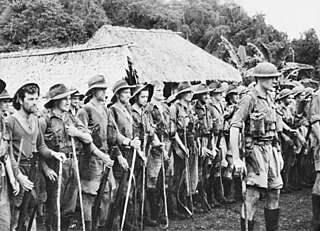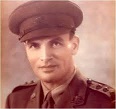Related Research Articles
Maroubra Force was the name given to the ad hoc Australian infantry force that defended Port Moresby, Papua New Guinea from the Japanese, and was involved in the Kokoda Track Campaign of the Pacific War, World War II. The force was established by the Allies under the codename "Maroubra", referring to the troops in the forward area, it was one of many units forming the body of the New Guinea Force, the main Allied army formation in the South West Pacific Area during 1942.

The Kokoda Track campaign or Kokoda Trail campaign was part of the Pacific War of World War II. The campaign consisted of a series of battles fought between July and November 1942 in what was then the Australian Territory of Papua. It was primarily a land battle, between the Japanese South Seas Detachment under Major General Tomitarō Horii and Australian and Papuan land forces under command of New Guinea Force. The Japanese objective was to seize Port Moresby by an overland advance from the north coast, following the Kokoda Track over the mountains of the Owen Stanley Range, as part of a strategy to isolate Australia from the United States.

Tomitarō Horii was a lieutenant general in the Imperial Japanese Army during World War II. After graduating from the Imperial Japanese Army Academy in 1911, Horii served in China before undertaking a variety of regimental appointments. Following Japan's entry into World War II, he commanded a division during the capture of Guam before commanding the Japanese force that had been given the task of capturing Port Moresby. In November 1942, in the retreat from Oivi–Gorari, Horii drowned while attempting to canoe down the Kumusi River to reach Japanese forces defending Buna–Gona. His canoe was swept out to sea and capsized.

Merauke Force was an Australian-led military force of World War II which was responsible for defending Merauke in Dutch New Guinea from Japanese attack amidst the Pacific War. The force was established in late 1942 and was disbanded at the end of the war, having never seen combat. The Japanese attack did not eventuate and from mid-1944 the force was progressively drawn down and its assigned units redeployed to Australia or elsewhere in the Pacific. At its height, Merauke Force included troops from Australia, the Netherlands East Indies and the United States, as well as several squadrons of aircraft, including a joint Australian-Dutch fighter unit.

Kanga Force was the name given to a composite ad hoc formation of the Australian Army that served in New Guinea during World War II. Commanded by Major Norman Fleay, it was formed on 23 April 1942. Made up of elements from the 1st and 2/5th Independent Companies and the New Guinea Volunteer Rifles (NGVR), Kanga Force conducted a number of small scale raids and reconnaissance operations around Lae and Salamaua before it was disbanded and the individual units became part of the Australian 3rd Division in 1943.

The Invasion of Buna–Gona, called Operation RI by the Japanese, was a military operation by Imperial Japanese forces to occupy the Buna–Gona area in the Territory of Papua during the Pacific campaign of the Second World War. The initial landings and advance on Kokoda occurred between 21 and 27 July 1942. The Japanese invaded and occupied the location in preparation for an overland attack on Port Moresby along the Kokoda Track. The landing marked the start of the Kokoda Track campaign. The landings were not directly opposed by land forces but were engaged by elements of Maroubra Force as they advanced on Kokoda. This initially included B Company of the 39th Battalion, patrols of the Papuan Infantry Battalion (PIB) operating in the area and a small number of the Australian New Guinea Administrative Unit (ANGAU) that became attached to the force. The Australians were initially repulsed near Oivi but subsequently regrouped to defend Kokoda in an initial battle there from 28–29 July.
Lieutenant Colonel Gordon Grimsley King, DSO was an officer of the Australian Army during the Second World War.
Mud Bay is a bay on the south eastern coast of Goodenough Island in the Milne Bay province of Papua New Guinea.
Taleba Bay is a bay on the south western coast of Goodenough Island in the Milne Bay province of Papua New Guinea. The bay was the site of the landing of 120 troops of the Australian Army's 2/12th Infantry Battalion led by Major Keith Gatewood on 22 October 1942 as part of the Battle of Goodenough Island.

The 2/4th Pioneer Battalion was a unit of the Australian Army raised for service during the Second World War. A pioneer unit, the battalion undertook both infantry and engineer tasks. Despite being raised early in the war, the battalion did not see action until the final months, taking part in the Borneo campaign where, as part of the 1st Beach Group, it fought against the Japanese in support of the 9th Division. It was disbanded in early 1946 following the end of hostilities.

The 1st Mountain Battery was an Australian Army artillery battery formed in July 1942, that served during the Second World War, seeing action against the Japanese during the Battle of Buna–Gona and the Salamaua–Lae campaign in 1942–43. The unit was added to the 1st Parachute Battalion in August 1944 providing an organic indirect fire support, equipped with Short 25-pounder guns, but did not see further action in this role. The battery was disbanded in 1946.
The Raid on Salamaua was a conducted by Australian commandoes during the New Guinea campaign of World War II on 28 June 1942. It has been called the first offensive action on land against the Japanese in World War II. The raid was undertaken by 2/5th Commando Squadron (Australia) under the command of Captain Norman Winning. According to one account, "The raid has been acclaimed as a copybook action for its diligent scouting, meticulous planning and audacious, multi-pronged attack against an enemy force 10 times the attackers' strength. All without loss of life."
The Raid on Heath's Farm was conducted by Australian commandoes in New Guinea on 1 July 1942. It followed the Salamaua Raid and took place 7 miles (11 km) outside of Lae. 44 Japanese were killed.
The Raid on Mubo was a raid by Australian commandos on the Japanese base at Mubo in New Guinea in World War II conducted on 1 October 1942. A party of 60 soldiers from the 2/5th Commando Squadron (Australia) under Norman Winning attacked the Japanese base. It was estimated up to 50 Japanese were killed.

Captain Herbert Thomson "Bert" Kienzle was an Australian soldier and plantation owner from the Territory of Papua. He is notable for his contribution as officer in charge of native labour supporting Australian forces fighting along the Kokoda Track. He identified and named the dry lake beds, Myola, that were to become an important supply dropping area and staging point during the Kokoda Track campaign. In later life, he was recognised for his contribution to the development of Papua New Guinea.
Chaforce was an ad hoc Australian infantry force formed during the Kokoda Track Campaign of the Pacific War, World War II. It was nominally of battalion size but consisting of only three rifle companies and a headquarters element, it was therefore proportionally smaller, with an initial strength of 407 all ranks.

The First Battle of Eora Creek – Templeton's Crossing was fought from 31 August 1942 to 5 September 1942. Forming part of the Kokoda Track campaign of the Second World War, the battle involved military forces from Australia, supported by the United States, fighting against Japanese troops from Major General Tomitaro Horii's South Seas Detachment who had landed in Papua in mid-1942, with the intent of capturing Port Moresby. The battle was one of three defensive actions fought by the Australians along the Kokoda Track. The fighting resulted in the delay of the Japanese advance south, which allowed the Australians to withdraw to Efogi. Eora Creek village and Templeton's Crossing was subsequently the site of a battle in late October 1942 as the Australian forces pursued the Japanese forces retiring back toward the north coast of Papua.

Templeton's Crossing is a locality on the Kokoda Track in New Guinea. The original track, at the start of the Kokoda Track campaign, proceeded north from Kagi and crossed over the watershed of the Owen Stanley Range as it passed through "the Gap" – skirting the eastern side of Mount Bellamy. The track then proceeded north through the steep-sided Eora Creek valley. Templeton's Crossing is where the original track first crosses Eora Creek. It was named by (then) Lieutenant Bert Kienzle in memory of Captain Sam Templeton. Templeton commanded B Company, 39th Battalion. It was the first of the battalion's companies to deploy overland for the defence of Kokoda – arriving shortly before the Japanese landings. Templeton was killed in the early stages of the Japanese advance. Kienzle was an officer of the Australian New Guinea Administrative Unit, that had been tasked, among other things, to establish supply dumps and staging points along the track. In the course of this, he was to guide Templeton's B Company over the track as it deployed.
Myola is a locality on the Kokoda Track in the Territory of Papua and the modern state of New Guinea. It is one of two closely located dry lake beds located near where the Kokoda Track crosses the crest of the Owen Stanley Range – also known as "the Gap" or "the Kokoda Gap". Myola, the smaller of the two lake beds, was located and named by Lieutenant Bert Kienzle on 3 August 1943. It became a major resupply point and drop zone for Australian forces during the Kokoda Track campaign. Kienzle then cut a track toward Eora Creek which rejoined the original track at Templeton's Crossing, which he also named.
The 21st Independent Mixed Brigade was an infantry brigade of the Imperial Japanese Army raised during World War II. Formed in January 1941 in Osaka, Japan, the brigade consisted of a single infantry regiment and support elements. It undertook occupation duties in Indochina before being sent to Malaya and then Rabaul. In late 1942, the brigade was sent to take part in the Battle of Buna–Gona in New Guinea. It was withdrawn to Rabaul, and then Japan, in June 1943. Elements of the brigade were converted into other formations and the formation ceased to exist in July 1943.
References
- ↑ McCarthy, Dudley (1959). South – West Pacific Area – First Year: Kokoda to Wau. Australia in the War of 1939–1945. Series 1 – Army. Volume 5 (1st ed.). Canberra: Australian War Memorial. pp. 193–224. OCLC 3134247.
- ↑ James, Bill (2008). Field Guide to the Kokoda Track: An Historical Guide to the Lost Battlefields. Lane Cove: Kokoda Press. p. 312. ISBN 9780977570409.
- ↑ McCarthy, Dudley (1959). South – West Pacific Area – First Year: Kokoda to Wau. Australia in the War of 1939–1945. Series 1 – Army. Volume 5 (1st ed.). Canberra: Australian War Memorial. pp. 193–224. OCLC 3134247.
Coordinates: 9°00′S147°44′E / 9.000°S 147.733°E